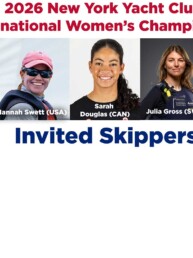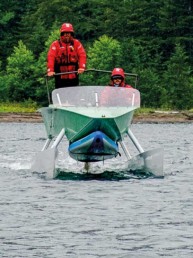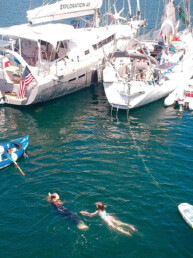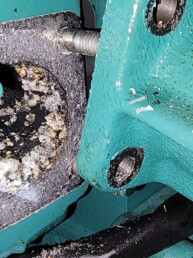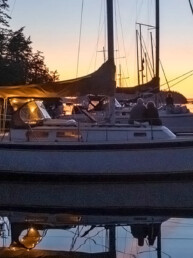This article was originally published in the August 2021 issue of 48° North.
Sailors, racers in particular, are a small community. I have only written these words one other time: a local racer lost his life on the water. A friend to many, an active member of the Seattle sailing community, and someone who gave back as a volunteer at Washington Yacht Club — Greg Mueller died doing what he loved. All of us here at 48° North extend our deepest condolences to those who knew and loved Greg, and any who are affected by his loss. And we honor Greg’s life, his passion for sailing, and his commitment to sharing it with others.
Tragedies in our sport are, thankfully, rare; but when they occur it is difficult to process, and available details are seldom 100% conclusive. In writing this article, I strove to explore these devastating events while avoiding finger pointing, Monday morning quarterbacking, or speculative ‘what-ifs?’. Attempting to learn more about what happened is a natural human response, but it is also an opportunity for other sailors to reflect on everything from possible takeaways in this incident to the risks we all accept when we go out on the water.
This is not an exhaustive investigative report and should not be viewed as such. Though I did communicate with several others involved in the rescue effort, the specifics herein are as remembered by one sailor who was on the boat when it happened, and who has been open about sharing his recollections of the tragic day.
Amidst the joyous return of Race Week — a Pacific Northwest classic now hosted in Anacortes that was graced with hot summer sun and superb racing conditions this year — a tragic accident resulted in the loss of Gregory Mueller, a sailor on the J/120 With Grace.
From what we can gather, there are some unknowns as to the circumstances. The Skagit Valley Coroner’s Office has published its preliminary report that states, “The cause of death has been determined as salt water drowning and the manner of death is accident.” At press time, the Coroner’s Office is still in the process of pathology analysis that should provide clarity or closure about whether the deceased could have had a medical event that contributed to the situation. This story presumes the initial report is accurate and considers the incident accordingly, but it is important to note that the full investigation is not yet complete.
Chuck Skewes, professional sailor and owner of several West Coast Ullman Sails lofts, was on With Grace at the time of the incident and was involved in the rescue effort. He was willing to share what he remembers about the experience. He described it as follows:
The accident took place during a final jibe to starboard on approach to the leeward mark in the second race of Race Week’s second day. The wind was about 12 knots, maybe gusting 15, and the water was mostly flat with small wind waves. Chuck recalls, “It was ideal sailing, smooth water, great pressure, warm weather, nothing extreme in any manner… how fast the tables turned on what was a perfect sailing day.”
The With Grace team had time to discuss and prepare for the maneuver — it wasn’t unusually hurried — and Chuck estimates that they began the jibe about 300 yards from the mark. As the bowman, Greg’s duty in the jibe was to use the spinnaker sheet that would become the working sheet — in this case, the portside sheet — to help pull the sail around the forestay and then help run the clew aft to fill the sail. For the non-racers out there, this helps flip the big downwind sail from one side to the other quickly and smoothly, while hopefully keeping the sail and the lines attached to it from getting caught on anything.
Chuck didn’t see exactly how it happened, but as the sail started to fill on the port side after the jibe, he heard Greg say, “Oh no,” and Chuck looked up to see him being pulled toward the lifelines with his ankle caught in the working spinnaker sheet between the sail’s clew and the turning block on the aft port side deck. As the sail filled, the force pulled Greg over the lifelines by his ankle. Greg grabbed the lifeline but was unable to hold on and was pulled off the boat upside down.
Chuck noted how the sheet never appeared to slip once it was on Greg’s ankle. It could have been a half-hitch (it looked that way to others on the boat) or could have been a wrap compounded by the way Greg twisted when he went over, or both. One way or another, it seemed to create a solid bight of line around his ankle and the line stayed tight on his ankle even though the spinnaker sheet was released.
Once off the boat, Greg was pulled away from the hull by the spinnaker clew, “more than an arm’s length from the boat,” Chuck says — winding up approximately six feet abeam off the port side and suspended upside down four to six feet above the water. Even though the crew had cast off the end of the spinnaker sheet he was attached to, Greg’s weight was trimming the sail, keeping the sail full and the boat moving forward at speed. Chuck saw Greg make an effort to do a sit-up motion to reach his ankle, but he wasn’t able to pull himself far enough up.
After only a few seconds, Greg began to drag in the water and Chuck saw water go over his face immediately. His inflatable life jacket deployed, but was quickly pulled up toward his head by the force of the water. Being pulled up and forward by his ankle, Greg was oriented with his head down in the water. Chuck remembers starting a mental clock when Greg’s head went underwater. According to a New England Journal of Medicine review from 2012 by Szpilman, Bierens, Handley, and Orlowski (all medical doctors), “The whole drowning process, from submersion or immersion to cardiac arrest, usually occurs in seconds to a few minutes…” There may be variation in the survival window across drowning incidents; nonetheless, the mental clock is a good practice that’s recommended in Safety at Sea courses, since having an estimate of the time a person has gone without oxygen could help inform actions in the rescue effort.
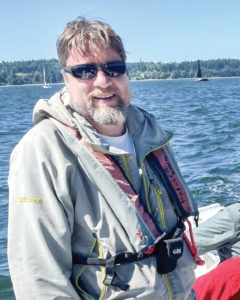
Around the deck of With Grace, the whole crew was taking actions to address the situation. One person put out a VHF call. Chuck says he released the spinnaker halyard in an effort to slow the boat’s forward motion. The helmsman drove the boat to weather and Greg passed the aft port quarter. Even with the sails luffing and the boat turned upwind, Chuck thinks there was still about 1.5 knots of boat speed, enough to keep dragging Greg through the water with some force. Since lines attached to the spinnaker had been eased, Greg was about 15 feet astern of the boat at this point. Another crew member pulled the spinnaker sheet to bring Greg’s body closer to the transom while Chuck went down the swim ladder on the swimstep, ready to assist immediately when he could reach him.
When Chuck got ahold of Greg from the swim ladder, he was face down in the water with his life jacket and shirt off one shoulder and around his head and neck. Chuck “grabbed the back of his collar and pulled his head above water and he had quite a bit of foam in his mouth.” He wasn’t breathing and was non-responsive. Chuck’s estimate of the total time on his ‘mental clock’ from when Greg’s head went underwater to when Chuck turned him over at the transom is between 90 seconds and 2 minutes.
For the crew, getting Greg out of the water was another challenge. Greg was a big guy — taller than six feet and approximately 250 pounds — and the boat’s freeboard made it difficult. They couldn’t lift him by his life jacket or clothing because each would just pull up over his head. Eventually, they removed his life jacket in order to get a LifeSling around him and under his arms. It was only with the LifeSling that they were able to bring Greg on deck. Chuck estimates between 6 and 7 minutes passed between when he turned Greg over and when the crew was able to get Greg on deck and begin CPR.
The crew took turns administering CPR until they were able to transfer Greg to the powerboat boat captained by Jared Hickman, the US Sailing Chief Judge on the water for Race Week. Chuck recognized how assertive and helpful Jared was in his response. Jared transported Greg to Guemes Island where the rescue effort transitioned to the local medical authorities. The crew wasn’t even back to the dock before they learned the heartbreaking news that Greg had succumbed.
In discussing all of this with Chuck, it was clear that throughout his lifetime on the water, he’d never seen or heard of an accident quite like this. He said he’s been racking his brain for takeaways in the days since the incident, but he’s having trouble coming up with many, in part because everything transpired in such a uniquely problematic freak-accident fashion. At the time of our conversation, he had this to offer other sailors: “Every person on every boat must do absolutely everything they can to keep a person on the boat. Once a person is on the other side of the lifelines and in the water in any way, it becomes much more difficult to help them.” Chuck’s other thought about what might have helped in this situation was that if Greg’s life jacket had been equipped with crotch straps, it’s possible the crew could have used the life jacket to help pull him on board more quickly.
Sailboat racing is, by and large, a safe sport, especially when it is done in inshore surroundings. Yet, the nature of the sport is also to be on fast boats, sailing close to the edge and pushing for speed or advantages. Benign conditions aren’t a forcefield against danger. And even when you’re doing everything right — sailing on a familiar boat with trained crew and appropriate recovery gear on board, talking through maneuvers in advance, wearing a life jacket — a tragedy can still occur.
Fair winds to you, Greg. Again, we offer our sympathies to Greg’s family and friends; and our hearts go out to the With Grace crew and everyone else who worked valiantly to try to save him. And please — sail safe, everyone.
Joe Cline is the Managing Editor of 48° North.
Joe Cline
Joe Cline has been the Managing Editor of 48° North since 2014. From his career to his volunteer leadership in the marine industry, from racing sailboats large and small to his discovery of Pacific Northwest cruising —Joe is as sail-smitten as they come. Joe and his wife, Kaylin, have welcomed a couple of beautiful kiddos in the last few years, and he is enjoying fatherhood while still finding time to make a little music and even occasionally go sailing.

